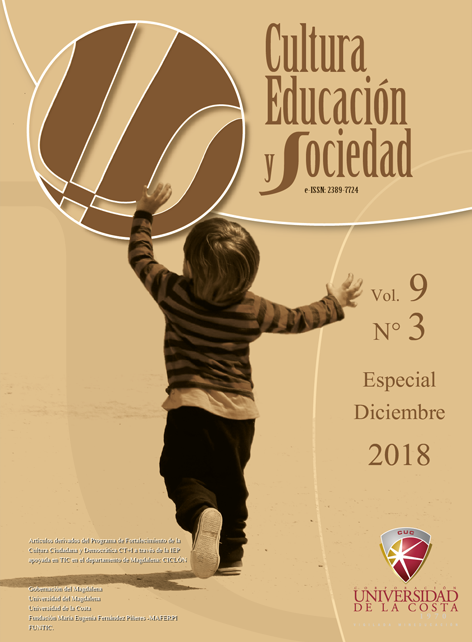The tics as tools for the prevention of digestive diseases in the students of the I.E.D San Jose de pueblo Viejo under the model of research as a pedagogical strategy (IEP)
DOI:
https://doi.org/10.17981/cultedusoc.9.3.2018.77Keywords:
dietary habits, digestive system, digestive diseasesAbstract
The development of good eating habits in students is important to alleviate some diseases of the digestive system and obtain a balanced diet in elementary school students. The objective of this study is to raise awareness about the relationship of the food source in students and its direct relationship with diseases associated with the digestive system. An approach was made under the qualitative approach using the type of research -a participatory action, the development of the research model as an IEP pedagogical strategy, from a descriptive design, where techniques such as observation and tools such as field diary and interviews are used. He associated with students and parents.
It is taken into account in 60 students of La I.E.D. San José de Pueblo Viejo of the fifth grade of the N ° 2 headquarters and 60 parents of families. They were found as a result of visits and sensitization, which both parents and students took corrective measures for the reduction of digestive diseases, while the habits of the stories such as: washing hands, in possible feeding in the same hours and time, wash the food very well, not cut the cold chains among others.
Downloads
References
Burgos, N. (2007). Alimentación y nutrición en edad escolar. Revista Digital Universitaria, 8(4), 1067-6079.
Cabello, R. R. (2007). Microbiología y parasitología humana/Microbiology and Human Parasitology: Bases etiologicas de las enfermedades infecciosas y parasitarias/Etiological Basis of Infectious and Parasitic Diseases. Ed. Médica Panamericana.
Castillo Reinosa, M. (2012). La nutrición en el marco de la educación para la salud, un instrumento para incidir en el aumento de resiliencia y en el proyecto de vida del educando (Doctoral dissertation). Universidad Nacional de Colombia.
Capuz, J. (2017) Estrategias educativas para la prevención de la enfermedad diarreica aguda en los niños menores de cinco años que asisten al centro de salud morete puyo. (Tesis de pregrado). Universidad Regional Autónoma De Los Andes.
Carrillo S., M., Pita R., G., Díaz, M. E., Mercader, O., & Wong, I. (2009). Evaluación nutricional de niños de 10 a 14 meses de edad. Revista Cubana de Pediatría, 81(3).
Losada, I. M. (2011). Nutrición para el bienestar. Editor: Lulu.com.
Guzmán, R. (2007) Nutrición y rendimiento físico en bailarines profesionales (Tesis de pregrado). Universidad de Chile.
Hernández, Fernández, y Baptista, 2010 Metodología de la investigación. México, México D.F., Mac GarwHill
Hernández-Gil, Fernández-Tresguerres (2010), I. F. T. Introducción al aparato digestivo. Cavidad bucal. HUMANA, 682.
Herrera Haro, N. J. (2014). Estudio comparativo del estado nutricional con el desarrollo mótriz de niñas y niños de 3 a 5 años del Centro de Educación Inicial Muñequitos de Lumbisi (Bachelor's thesis). Universidad de las Fuerzas Armadas ESPE.
Mejia Jimenez, R. (2011). La investigación como estrategia pedagógica una apuesta por construir pedagogías críticas en el siglo XXI. Praxis & Saber, 2(4)127-177
National Institute of Diabetes and Digestive and Kidney Diseases [NIDDK] (2008). Aparato digestivo y su funcionamiento. (08–2681S). Recuperado de https://www.niddk.nih.gov/health-information/informacion-de-la-salud/enfermedades-digestivas/aparato-digestivo-funcionamiento
National Library of Medicine (2017) Enfermedades del sistema digestivo: MedlinePlus. Recuperado de https://medlineplus.gov/spanish/digestivediseases.html#cat_51
Noguera Brizuela, D., Márquez, J. C., Campos Cavada, I., & Santiago, R. (2013). Alimentación complementaria en niños sanos de 6 a 24 meses. Archivos venezolanos de puericultura y pediatría, 76(3), 126-135.
Olivares, S., Bustos, N., Moreno, X., Lera, L., & Cortez, S. (2006). Actitudes y prácticas sobre alimentación y actividad física en niños obesos y sus madres en Santiago, Chile. Revista chilena de nutrición, 33(2), 170-179.
Romero, R., (2013) Promoción de hábitos alimentarios saludables de la escuela. (Tesis de pregrado). Universidad de Valladolid.
Ruiz-Martínez, E., Álvarez-Martínez, I., & Ruiz-Jaramillo, M. C. (2012). Hábitos de alimentación en niños con sobrepeso y obesidad. Pediatría de México, 14(3), 124-132.
Santos Muñoz, S. (2005). La Educación Física escolar ante el problema de la obesidad y el sobrepeso. Revista Internacional de Medicina y Ciencias de la Actividad Física y del Deporte/International Journal of Medicine and Science of Physical Activity and Sport, 5(19).
Downloads
Published
How to Cite
Issue
Section
License
Copyright (c) 2018 CULTURA EDUCACIÓN Y SOCIEDAD

This work is licensed under a Creative Commons Attribution-NonCommercial-NoDerivatives 4.0 International License.
![]()
Creative Commons 2020 CULTURA EDUCACIÓN Y SOCIEDAD
This article is under international license Creative Commons Reconocimiento-NoComercial-SinObrasDerivadas 4.0.
The published articles are the sole responsibility of their authors and do not necessarily reflect the opinions of the editorial committee.
CULTURA EDUCACIÓN Y SOCIEDAD respects the moral rights of its authors, who assign to the editorial committee the patrimonial rights of the published material. In turn, the authors inform that this work is unpublished and has not been previously published.
All articles are under a:
Licencia Creative Commons Atribución-NoComercial-SinDerivadas 4.0 Internacional.
![]()


 English
English
 Español (España)
Español (España)




_12.53_.27_p_. m_._3.png)





_12.57_.35_p_. m_._3.png)
_12.50_.37_p_. m_._3.png)



